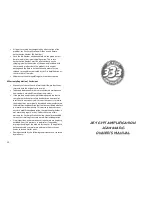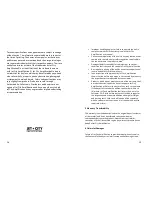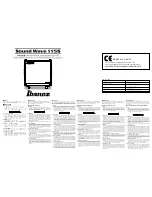
6
1 2 3 4 5 6 7 8 9 10 11 12 13 14 15
1
Input Jack: Guitar cable goes here (the other end should
probably be in the guitar)
2
CLEAN Volume: Adjust the amount of volume that the
amplifier produces in the CLEAN Channel. The CLEAN
channel is designed for maximum headroom, so don’t be
afraid to turn it up!
3
BASS: Part of the CLEAN channel 3-band EQ for adjusting low
frequencies
4
MID: Part of the CLEAN channel 3-band EQ for adjusting
middle frequencies
5
TREBLE: Part of the CLEAN channel 3-band EQ for adjusting
high frequencies
6
CRUNCH Gain: Adjust the amount of gain (distortion) that
the amplifier produces in the CRUNCH Channel. Keep it low
for crystal clear cleans, or dial it up for some tube overdrive.
7
BASS: Part of the CRUNCH channel 3-band EQ for adjusting
the low frequencies.
8
MID: Part of the CRUNCH channel 3-band EQ for adjusting
the middle frequencies.
9
TREBLE: Part of the CRUNCH channel 3-band EQ for adjusting
the high frequencies.
10
CRUNCH Master Volume: Lets you adjust how loud the
CRUNCH channel’s output will be.
11
REVERB: Adjusts the “depth” of the built in reverb.
12
PRESENCE: Adds an overall brightness, which can be handy
when trying to cut through in a ‘dead’ room.
7
13
STANDBY switch: Used in conjunction with the main POWER
switch (item 12). Use the STANDBY to “warm up” your amp’s
tubes before turning on the PWER switch. Always put the
amp in STANDBY before turning the main power switch on or
off!
14
POWER switch: This is the main power switch for the entire
amp. Be sure that your amp is switched off AND unplugged
before moving it!
15
Power Indicator Light: The pretty light glows blue when your
amp is on.
TUBE AMP BASICS
1.
Can you really die from messing around with the guts of
tube amp?
Yes, you can. Tube amps carry significant voltage, even
when turned off. DO NOT mess with the insides of a tube
amp unless you are a trained tech.
2.
OK, question 1 scared me. Can I safely change my own
tubes?
Yes, you can. The dangerous voltages are only a problem if
you start messing with wires and transformers. It is perfectly
safe to change your own tubes.
3.
How often should I change tubes?
There is no set timeline for changing tubes. If you play ever
day, a good rule of thumb is to replace your power tubes
once a year and your preamp tubes every other year.
However, it is entirely possible for tubes, particularly preamp
tubes, to last decades.
Here are some signs that you need to change your tubes:
•
Excessive noise like squealing, humming, or hiss


























